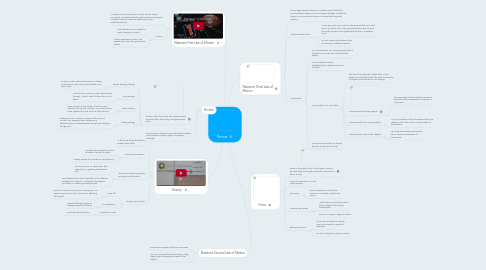
1. Friction
1.1. Friction is the force that two surfaces exert on each other while they rub against each other.
1.1.1. Kinetic Energy (Sliding)
1.1.1.1. Kinetic Friction (otherwise known as sliding friction) when two solid surfaces slide over each other.
1.1.2. Fluid Energy
1.1.2.1. Fluid friction is when a solid object moves through a fluid. That fluid can be air or a liquid.
1.1.3. Static Friction
1.1.3.1. Static Friction is the friction that acts upon objects that are not moving. One must exert a force greater than the forve of static friction
1.1.4. Rolling Energy
1.1.4.1. Rolling Friction is when an objects rolls across a surface. For example when someone is skateboarding, the skateboard's wheels are rolling on the ground.
1.2. The causes of friction are how hard the surfaces push together and the types of surfaces involved.
2. Gravity
2.1. Is the force that pulls objects toward each other
2.2. Universal Gravitation
2.2.1. Gravity acts everywhere in the universe, not just on earth.
2.2.2. Gravity causes the planets to orbit the sun.
2.3. The factors affecting gravity are mass and distance.
2.3.1. The more mass an object has, that objects has a greater gravitational pull.
2.3.2. Gravitational force also depends on the distance between two objects. The farther the objects are, there is a lesser gravitational pull.
2.4. Gravity and Motion
2.4.1. Free fall
2.4.1.1. Free fall is when the only force acting upon an object is gravity. No other forces are affecting the object.
2.4.2. Air Resistance
2.4.2.1. Objects falling through air experiencing fluid friction,
2.4.3. Projectile Motion
2.4.3.1. Any object that is thrown
3. Newtons First Law of Motion
3.1. An object at rest will remain at rest, and an object moving at a constant velocity will continue moving at a constant velocity, unless its acted upon by an unbalanced force.
3.2. Inertia
3.2.1. Is the tendency if an object to resist change in motion,
3.2.2. Inertia depends on mass. The greater the mass, the greater the inertia.
4. Newtons Second Law of Motion
4.1. Accelerarion equals Net force over mass.
4.2. You can increase the acceleration of any objects by changing the mass of that object.
5. Newtons Third Law of Motion
5.1. If one object exerts a force on another object, then the second object exerts an force of equal strength on the first object. For every action there is an equal but opposite reaction.
5.2. Action Reaction Pairs
5.2.1. When you jump, you push on the ground with your feet, this is an action force. The ground pushes back on your feet with an equal and opposite force this is a reaction force.
5.2.2. Do not cancel out because they are acting on different objects.
5.3. Momentum
5.3.1. Is a characteristic of a moving object that is related to the mass and velocity of the object.
5.3.2. Can be determined by multiplying the objects mass and velocity,
5.3.3. Conservation of Momentum
5.3.3.1. The law of conservation states that, in the absence of outside forces, the total momentum of objects that interact do not change.
5.3.3.2. Collisions with moving objects
5.3.3.2.1. The momentum of one object increases while the other decreases. Momentum is conserved.
5.3.3.3. Collisions with one moving object
5.3.3.3.1. All of momentum will be transferred from on object to the other. This is conservation of momentum.
5.3.3.4. Collisions with connected objects
5.3.3.4.1. The total momentum remains the same. This is conservation of momentum
5.3.4. The more momentum an object has, the harder it is to stop.
6. Force
6.1. Force is the push or pull of an object. Force is described by its stength and by the direction in which it acts.
6.2. Force is measured in SI unit called newton.
6.3. Net Force
6.3.1. The combination of all forces acting on an object is called net force.
6.4. Unbalanced Forces
6.4.1. When there is a net force actin upon a object, the force is unbalanced.
6.4.2. Cause a change in objects motion
6.5. Balanced Forces
6.5.1. When equal forces are acting upon one object in opposite direction.
6.5.2. Do not change the objects motion
